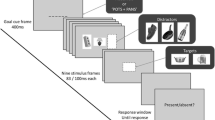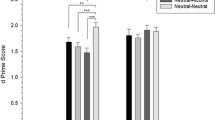Abstract
Rationale
Attentional bias for alcohol-related cues is associated with the motivation to drink alcohol, possibly because attentional bias increases craving.
Objectives
We examined whether an experimentally induced attentional bias would influence subjective and behavioural indices of the motivation to drink.
Methods
Heavy social drinkers (N=40) completed an attentional training procedure, in which half of the participants were trained to direct their attention towards alcohol-related cues (‘attend alcohol’), and half of the participants were trained to direct their attention away from alcohol-related cues (‘avoid alcohol’). After attentional training, participants rated their urge to drink alcohol, and the amount of beer consumed during a taste test was measured.
Results
The attentional training procedure produced significant changes in attentional bias in the predicted direction in both experimental groups. Attentional training produced an increase in the urge to drink alcohol in the attend alcohol group, and the attend alcohol group consumed more beer than the avoid alcohol group during the taste test.
Conclusions
These results suggest that a potentiated attentional bias for alcohol-related cues can increase the motivation to drink alcohol. Theoretical and clinical implications are discussed.




Similar content being viewed by others
Notes
Upon arrival at the laboratory, four participants reported levels of alcohol consumption that were slightly below this level. However, the results of all analyses were unaffected by the exclusion of these four participants, so they were retained in the study. Furthermore, across the entire sample, only one participant had a score below 8 on the AUDIT, which suggests that the majority of participants were ‘hazardous drinkers’ (see Babor et al. 2001).
References
Amir N, Beard C, Klumpp H, Elias J, Brady R, Hewett J (2004) Modification of attentional bias in social phobia: change in attention, generalizability across paradigms, and change in symptoms. Paper presented during the 34th annual congress of the European Association for Behavioural & Cognitive Therapies, Manchester, 9–11 Sept 2004
Babor TF, Higgins-Biddle JC, Saunders JB, Monteiro MG (2001) The alcohol use disorders identification test: guidelines for use in primary care, 2nd edn. World Health Organisation, Geneva
Bradley BP, Mogg K, Wright T, Field M (2003) Attentional bias in drug dependence: vigilance for cigarette-related cues in smokers. Psychol Addict Behav 17:66–72
Carter BL, Tiffany ST (1999) Meta-analysis of cue-reactivity in addiction research. Addiction 94:327–340
Cox WM, Hogan LM, Kristian MR, Race JH (2002) Alcohol attentional bias as a predictor of alcohol abusers' treatment outcome. Drug Alcohol Depend 68:237–243
de Jong PJ, Kindt M, Roefs A (2005) Do implicit drug-related cognitions have causal effects on craving and substance misuse? Findings from experimental psychopathology. In: Wiers R, Stacy A (eds) Handbook of implicit cognition and addiction. Sage, Thousand Oaks (in press)
Derryberry D, Reed MA (2002) Anxiety-related attentional biases and their regulation by attentional control. J Abnorm Psychol 111:225–236
de Wit H, Chutuape MA (1993) Increased ethanol choice in social drinkers following ethanol preload. Behav Pharmacol 4:29–36
Drobes DJ, Thomas SE (1999) Assessing craving for alcohol. Alcohol Res Health 23:179–186
Duka T, Townshend JM (2004) The priming effect of alcohol pre-load on attentional bias to alcohol-related stimuli. Psychopharmacology (Berl) 176:353–361
Edwards G (1996) Sensible drinking. Br Med J 312:1
Ehrman RN, Robbins SJ, Bromwell MA, Lankford ME, Monterosso JR, O'Brien CP (2002) Comparing attentional bias to smoking cues in current smokers, former smokers, and non-smokers using a dot-probe task. Drug Alcohol Depend 67:185–191
Field M, Mogg K, Zetteler J, Bradley BP (2004a) Attentional biases for alcohol cues in heavy and light social drinkers: the roles of initial orienting and maintained attention. Psychopharmacology (Berl) 176:88–93
Field M, Mogg K, Bradley BP (2004b) Eye movements to smoking-related cues: effects of nicotine deprivation. Psychopharmacology (Berl) 173:116–123
Field M, Mogg K, Bradley BP (2005a) Alcohol increases cognitive biases for smoking cues in smokers. Psychopharmacology (Berl) 180:63–72
Field M, Mogg K, Bradley BP (2005b) Attention to drug-related cues in drug abuse and addiction: component processes. In: Wiers R, Stacy A (eds) Handbook of implicit cognition and addiction. Sage, Thousand Oaks (in press)
Field M, Mogg K, Bradley BP (2005c) Craving and cognitive biases for alcohol cues in social drinkers. Alcohol Alcohol (in press). DOI 10.11093/alcalc/agh213
Franken IHA (2003) Drug craving and addiction: integrating psychological and neuropsychopharmacological approaches. Prog Neuropsychopharmacol Biol Psychiatry 27:563–579
Hobbs M, Remington B, Glautier S (2005) Dissociation of wanting and liking for alcohol in humans: a test of the incentive-sensitisation theory. Psychopharmacology (Berl) 178:493–499
Jones BT, Schulze D (2000) Alcohol-related words of positive affect are more accessible in social drinkers' memory than are other words when sip-primed by alcohol. Addict Res 8:221–232
Jones BT, Jones BC, Smith H, Copley N (2003) A flicker paradigm for inducing change blindness reveals alcohol and cannabis information processing biases in social users. Addiction 98:235–244
Love A, James D, Willner P (1998) A comparison of two alcohol craving questionnaires. Addiction 93:1091–1102
Lubman DI, Peters LA, Mogg K, Bradley BP, Deakin JFW (2000)Attentional bias for drug cues in opiate dependence. Psychol Med 30:169–175
MacLeod C, Rutherford E, Campbell L, Ebsworthy G, Holker L (2002) Selective attention and emotional vulnerability: assessing the causal basis of their association through the experimental manipulation of attentional bias. J Abnorm Psychol 111:107–123
Mathews A, MacLeod C (1985) Selective processing of threat cues in anxiety states. Behav Res Ther 23:563–569
Mathews A, MacLeod C (2002) Induced processing biases have causal effects on anxiety. Cogn Emot 16:331–354
Mattia JI, Heimberg RG, Hope DA (1993) The revised Stroop colour-naming task in social phobics. Behav Res Ther 31:305–314
Millisecond Software (2002) Inquisit 1.33 (computer software). Millisecond Software, Seattle
Mogg K, Bradley BP (1998) A cognitive-motivational analysis of anxiety. Behav Res Ther 36:809–848
Mogg K, Bradley BP, Field M, De Houwer J (2003) Eye movements to smoking-related pictures in smokers: relationship between attentional biases and implicit and explicit measures of stimulus valence. Addiction 98:825–836
Robinson TE, Berridge KC (2003) Addiction. Annu Rev Psychol 54:25–53
Rosse RB, Johri S, Kendrick K, Hess AL, Alim TN, Miller M, Deutsch SI (1997) Preattentive and attentive eye movements during visual scanning of a cocaine cue: correlation with intensity of cocaine cravings. J Neuropsychiatry 9:91–93
Sharma D, Albery IP, Cook C (2001) Selective attentional bias to alcohol related stimuli in problem drinkers and non-problem drinkers. Addiction 96:285–295
Townshend JM, Duka T (2001). Attentional bias associated with alcohol cues: differences between heavy and occasional social drinkers. Psychopharmacology (Berl) 157:67–64
Townshend JM, Duka T (2003) Avoidance of alcohol-related cues by alcoholic inpatients undergoing detoxification. Behav Pharmacol 14(Suppl 1):S69
Watts F, McKenna FP, Sharrock R, Trezise L (1986) Colour-naming of phobia-related words. Br J Psychol 77:97–108
Wiers RW, de Jong PJ, Havermans R, Jelicic M (2004) How to change implicit drug use-related cognitions in prevention: a transdisciplinary integration of findings from experimental psychopathology, social cognition, memory, and experimental learning psychology. Subst Use Misuse 39:1625–1684
Acknowledgement
This research was supported by a research grant from the British Academy (reference LRG-37196) awarded to the first author.
Author information
Authors and Affiliations
Corresponding author
Rights and permissions
About this article
Cite this article
Field, M., Eastwood, B. Experimental manipulation of attentional bias increases the motivation to drink alcohol. Psychopharmacology 183, 350–357 (2005). https://doi.org/10.1007/s00213-005-0202-5
Received:
Accepted:
Published:
Issue Date:
DOI: https://doi.org/10.1007/s00213-005-0202-5




